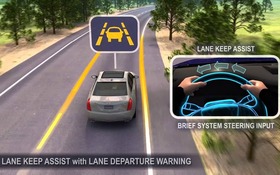Get Back on the Road, Safely
This article is an advertorial brought to you by a Car Guide Partner
Advanced Driver Assistance Systems or ADAS
Technology associated to the windshield is becoming increasingly more sophisticated. Most new vehicles now come standard with Advanced Driver Assistance Systems. These systems are intended to facilitate driving and reduce the risk of accidents. They rely upon a forward-facing camera mounted behind the windshield, intended to warn the driver of potential dangers on the road.
These are the most common systems used by vehicle manufacturers:
Lane Keep Assist (LKA): This system corrects a lane change that is not signaled by the driver by taking control of the steering wheel, in order to return the vehicle to its designated lane.
Lane Departure Warning System (LDW): This system notifies the driver via an audible and/or visual alert when the vehicle is veering out of its designated lane without the use of the lane change signal.
Forward Collision Alert (FCA): This system detects the distance between the driver's vehicle and the vehicle ahead. When the driver approaches too close, the system notifies the driver with an audible and/or visual warning.
Collision Mitigation Breaking System (CBMS): This system acts in the same way as the FCA. In addition to notifying the driver, it will apply the brakes automatically if the driver does not do so following the alert.
Adaptive Cruise Control (ACC): Adaptive Cruise Control maintains a safe distance from the vehicle ahead by automatically adjusting vehicle speed.
Calibration – Safety before all
Windshield calibration consists of bringing the driver assistance systems back to their original manufacturer settings. This process is crucial and essential after a windshield replacement to ensure these systems function properly as the camera must be displaced during installation. Lack of calibration could have terrible consequences, such as affecting the precision of the images and landmarks, providing poor quality information to these systems and affecting the safety of the driver and their passengers.
Types of Calibration
For safety reasons, it is necessary for the technician to perform a calibration following a windshield replacement, in accordance to the vehicle manufacturer's instructions. Varying high precision equipment is used to reset these systems to their original settings. This equipment is also used to verify and confirm that the camera is properly aligned on the vehicle.
The calibration process may vary from one vehicle to another. Vehicles may require a static and/or dynamic calibration.
Static Calibration
A static calibration is performed in the service bay during which the camera is calibrated using an electronic device, a laser and targets.
Dynamic Calibration
With the help of a portable electronic device, the technician calibrates the camera during a road test. The vehicle is placed in “learning mode” and relearns the necessary landmarks used by the driver assistance systems.
Entrust your windshield to the experts
Today, the replacement of your windshield increasingly relies upon sophisticated technology and must be entrusted to qualified technicians using the most advanced and reliable equipment available on the market.
Ensure to make your appointment with an expert and get back on the road, safely!










